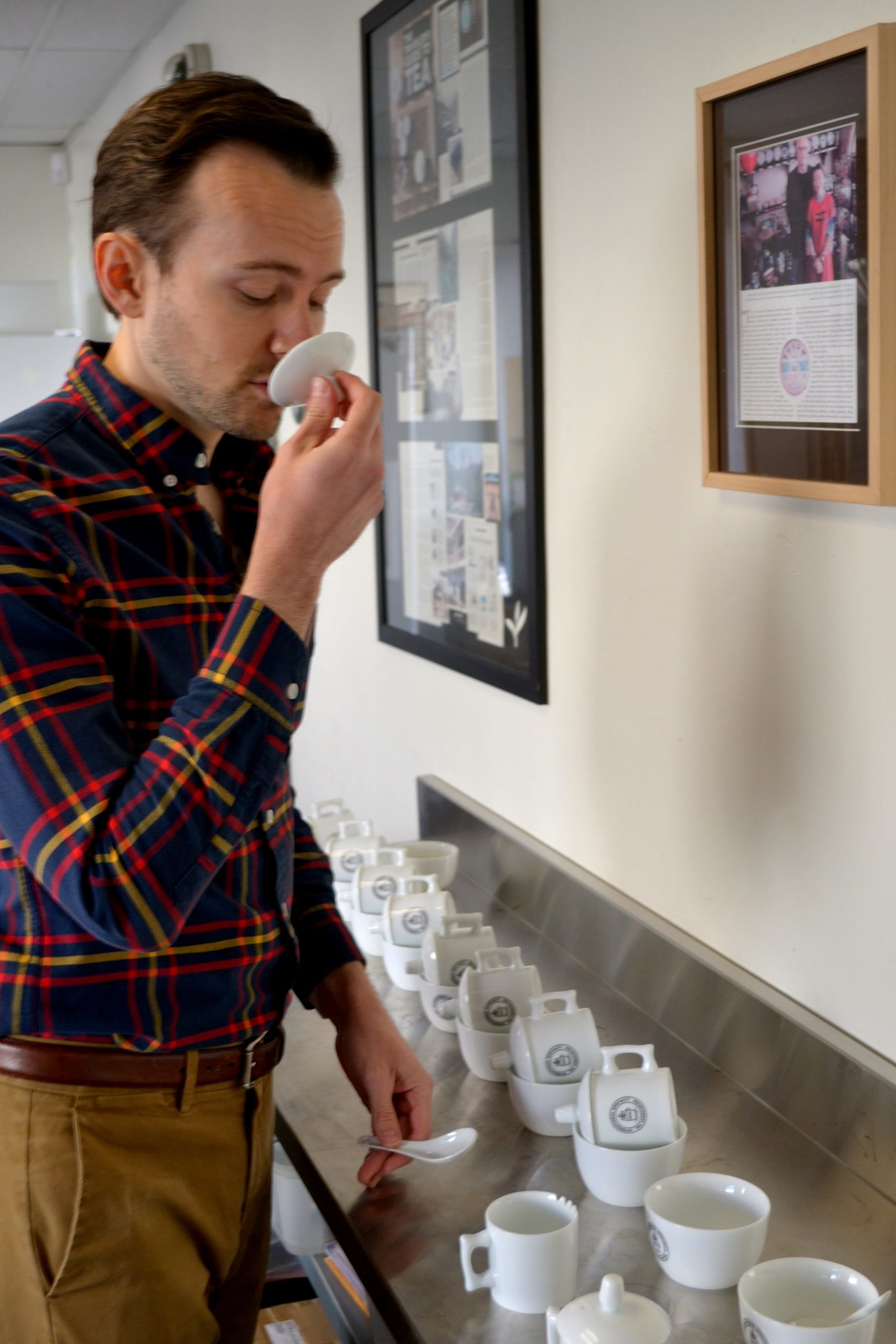
“Tea is the way I live my life,” says tea taster Andrew McNeill, at Seven Cups Fine Chinese Tea in Tucson, Ariz. “Tea is something you do carefully, attentive to taste in the way that tea demands.” McNeill says that “tea shapes the way I take in other experiences. It happens unwittingly, a process of premeditation that people talk about — not ritual meditation — at least not in a knowing way.” A graduate of the University of Arizona and schooled at the National Taiwan Normal University in Taipei, McNeill has worked at Seven Cup for almost 14 years. In 2012 Travel + Leisure named Seven Cups one of the six best places to drink tea in America. As Business Development Director, McNeill is a familiar face at trade events and a talented writer responsible for producing much of the content on the tea company’s well-respected website. McNeill, 37, is one of the founding members of the International Specialty Tea Association, a non-profit that strives to establish quality standards in tea making. Well-traveled, he describes himself as a people person who loves the outdoors. “We are just at the beginning of challenging times in tea,” observes McNeill, citing COVID-19, political tensions, low prices, and climate change. His optimism for the industry is rooted in a “global kinship in tea.”
“There is a remarkable feeling of a family with more in common than differences,” he said, adding “People in the business have a true passion. Consumers sense that and they are willing to support innovation as the industry adapts to these challenges.”
Q: When would you say you decided to pursue tasting as a professional skill? What first interested you about tasting?
My first job in tea was serving at a small cafe. The owners were very passionate and generous people who not only told all of the staff to drink as much tea as they could but also encouraged us to practice critical tasting and develop it as a skill. I got hooked on it then and there. Tasting is simply one of the most challenging and exciting (maybe even glamorous?) parts of working with tea. I remember reading a magazine article at the time about the years of apprenticeship commodity tea tasters go through. I was totally astonished. Not only were professional tasters a thing, but you could devote years of your life to developing the skill.
The thing is, though, tasting skills aren’t the exclusive domain of the mythic commodity taster. It’s part of the skillset if you work in tea at all — say you’re writing marketing copy for tea or (like I was) recommending teas over a café bar — you’re engaged in the labor of taste and language. Practicing your critical tasting skills is worth your time.
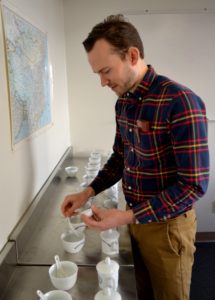
Q: What did you do prior to working in tea? Did this represent a shift for you in what you originally thought you would be doing as a career?
I was very lucky to stumble into tea from working odd jobs. I didn’t have a career path in mind, I was just trying to find something I was good at and could get paid for. I started my first job at that small tea cafe just after working as a factory hand for a book bindery. The flavors and aromas of a tea shop are much better than the scent of pigment and binding glue, so I was keen to stick with tea.
Q: Are there some teas that resonate? Teas which you are better at describing and better appreciate, even if they are not your personal favorites? If so, why do you think this is the case?
Black teas are (very generally speaking) a little easier for me to parse. I grew up with plenty of black tea around, so maybe it’s just deep Proustian familiarity. Maybe there’s also some bias in the system, too — the common cupping protocols were built with commodity black tea in mind. Black tea brewed in one shot with boiling water in a ceramic cupping set is not far off from the way we might brew a strong mug on our kitchen counter — it expresses its character more or less as you’d expect, whereas green tea and wulong brewed this way take a little more getting used to.
By the way, examining the limitations of common cupping protocols and making suggestions to better evaluate specialty tea is part of the work underway at the International Specialty Tea Association!
Q: Which teas were initially the most challenging for you? Are they still daunting? Or have you made peace with them and reached a mutual understanding? How so?
A: Yancha is a personal favorite and is also a style I find super challenging. To start with, its dark twisted leaves have fewer visual clues for quality than say, full leaf green or black tea. In comparative tasting, yancha teas are usually grouped by cultivar, but their processing is complex and capable of entertaining different approaches. Each approach makes wonderful but dramatically different characters in the infusion. It’s deceptive. You can easily find yourself in a cupping line of teas that are identical on the surface but suddenly discover this is really not an apple-to-apple comparison.
On top of the complex range of style characteristics, there is the challenge of micro-origin. Much of the marketing surrounding high-end yancha, much like Pu’er, is hyper-concerned with the leaf material coming from very specific and often very tiny patches of tea bushes. Since one of the expectations of a professional taster is to be able to verify the authenticity of an origin, you’ll soon find yourself in a pickle when you get this specific. When we’re splitting micro-origins into nano-origins, e.g. Niulankeng versus a stone’s throw away in Guidong, you should expect both to be outstanding tea, but verifying their exact growing spot by taste alone isn’t a practical expectation. The work of verifying such fine distinctions has to be done in conjunction with work on the ground, through building trusted relationships, knowing the fair price, and paying it.
Beyond that, you’ve got to make peace with Yancha’s complexity by focusing on the basics. For me, this means focusing on two things: 1. Is the tea well made (Is it free from defects? Are the flavors well developed, pleasant and complex?) and 2. was the material good (are the flavors lasting and persistent?)
Q: Will you share with readers some insights about the vocabulary of tea. What was the process like for you in going from identifying “something familiar”, perhaps relating it to a memorable experience or place, to being able to put a specific term to it?
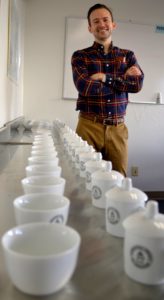
A: This is a great question! Language is a tool just as important to tea tasting as your nose and tongue.
It’s important to keep in mind that the vocabulary you use when tasting tea is contextual. It is determined by what you’re trying to communicate about the tea and to whom. Tasting work has multiple objectives and it doesn’t serve all of them at the same time. For example, the reason a brokerage house taster tastes tea is different from the reasons a retail vendor tastes tea, and vocabulary should follow the concerns of each context.
I personally think of tasting objectives as either having an orientation that’s either up the supply chain or down the supply chain.
When you’re doing up-chain tasting work, you’re concerned with evaluation and compliance — is the tea consistent with expectation? Is the tea free from defects? How is this tea different from a standard sample or a previous lot? What attributes can it contribute to my blend?
Here you are working to communicate actionable feedback on tea quality and characteristics to your supplier or your coworkers. Precision and consistency are what’s important and your vocabulary should serve this.
Different segments of the industry and companies use their standard lexicons or flavor wheels to address this. At Seven Cups, we’ve borrowed our terms from the Chinese national standard lexicon for tea. But it doesn’t really matter which one you’re using, as long as it’s consistent. There is not much room for self-expression here, but the language can still be really charming. Just think of the antique-sounding and precisely-defined terms in commodity black tea tasting — brisk, stewy, bakey etc!
Down-chain tasting is concerned with making an enticing description of the tea to a buyer. In the case of a consumer, maybe you just want to send an emotive description to a friend. Value is again contextual here, but it is looser, more abstract. The goal isn’t to rank teas in compliance with a standard or quality. Rather, vendors doing down-chain tasting are trying to align language with the tastes of their customers and their shared experience or aspirations. To borrow an example from the wine industry: the job of the sommelier is not judging a wine’s quality as it is to sell the wine. Much of the tasting work done in the so-called specialty tea industry has this orientation, which includes my own work at Seven Cups.
Down-chain tasting invites creative adventures into language and experience that is independent of a single lexicon. We tend to focus on concrete references to scents and aromas (malt, fresh hay, passion fruit, etc.), but bringing in more abstract descriptors to personify an overall quality can be effective too (somber, cracking, vaporous, etc.) Of course, your words have to describe something that touches on a shared experience — otherwise, it’s useless.
Q: Did you actively seek opportunities to build vocabulary? What were some of your exercises?
It’s really helpful to practice tasting with other people and see what vocabulary you both connect with.
I love blind tasting or smelling games too. Have you tried identifying all of the spices in your spice cabinet by scent alone? It’s a great dinner party game. It’s an experience that will come back to you at the cupping table, too.
Q: Is there an area of vocabulary you found easier and, similarly, an area you found more difficult? I noticed that some people get stuck on certain areas and struggle to evolve their vocabulary in that area, perhaps because they don’t allow personal time away from the cupping table to study the character (ie: what is vegetal? what is brisk? etc,)
The most difficult vocabulary relates to culture and translation. Recognizing that tea is as much a culture as it is a beverage, tasters ought to do their best to retain vocabulary from the culture it’s produced in. The challenging part is those flavor descriptions are deeply nested in our cultural upbringing. For example, classic descriptions of Chinese teas, like toasted soybean of Longjing and jujube date of shu puer, usually are not meaningful to western tasters, but I feel like it’s a sin to throw these terms out — you’d be losing part of the culture of their appreciation. If you’re doing up-supply-chain tasting work, you’d also be losing language to communicate with your suppliers in a consistent way.
This vocabulary becomes even more difficult when it relates an array of flavors (e.g. yanyun) or a feeling and effect (e.g. huigan, chun, and [most controversial] cha qi). These are challenging characteristics to understand, but I’d argue it’s important to make that effort.
Q: What advice would you give consumers seeking to refine their taste in tea during a period when it is more difficult to sample teas at their local tea shop, at community festivals, and while dining?
You can take your tea sampling virtual by organizing group buys with your friends. Order liberally from your favorite tea merchants and divide up the spoils into sample-size bags for everyone. Hang out and taste together over video chat, if you like. It takes a bit of coordination but it’s a great way to taste a broad range of teas and support your favorite shops.
Also, the pleasure and skill of tasting aren’t confined to tea. Everything you do informs everything else you do. If you’re focused on tasting Doritos, you’re still focused on tasting. Flexing those muscles informs how you taste tea. If you’re not able to sample tea, break into your spice cabinet, smell the types of grass that grow near your house, conduct a comparative tasting of fried chicken from fast-food joints. There’s more overlap here than you might think.
Tasting Notes
Jin Jun Mei
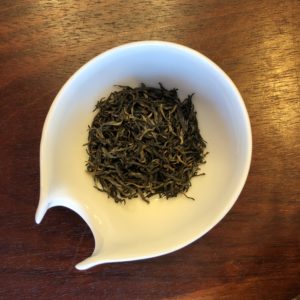
Tea Maker: Junde LIANG
Tea Bush: Tongmu Qizhong
Process type: Black Tea
Origin: Tongmu, Wuyishan, Fujian, China
Brewing recommendation: 120 ml Gaiwan, 4 grams dry leaf, boiling water, steep 30 seconds.
Product link: This tea is included with Seven Cups Signature Tea Passport subscription service.
Dry leaf: Mottled black and golden with prominent ash-grey down. Uniform plucking. Young, wiry, meticulously clean.
Liquor: Golden yellow to orange amber. Clear with suspended down.
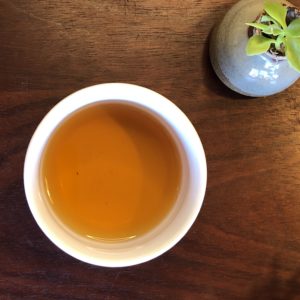
Cup: Biscuity with delicate Maillard aromas: light malt, pastry edges, fresh bread. Subsequent infusions bring on floral (dry rose), honey, and finally steamed yams. Aroma clings beautifully to infusion throughout. Mouthfeel is smooth, sweetness full, and persistent.
Personal Notes: Jin Jun Mei went from being a boutique one-off tea to a headline sensation, to a Dutch tulip market full of fakery, and finally into a style unto itself. No matter the hype, the original Jin Jun Mei still stands on its own with inimitable features — it’s mottled color, creeping pastry sweetness, and tiny, tiny leaves. Junde LIANG’s original is a testament that there’s a place for tea making focused on an all-out-money-no-object pursuit of perfection. When you sip it, you can hear that statement.
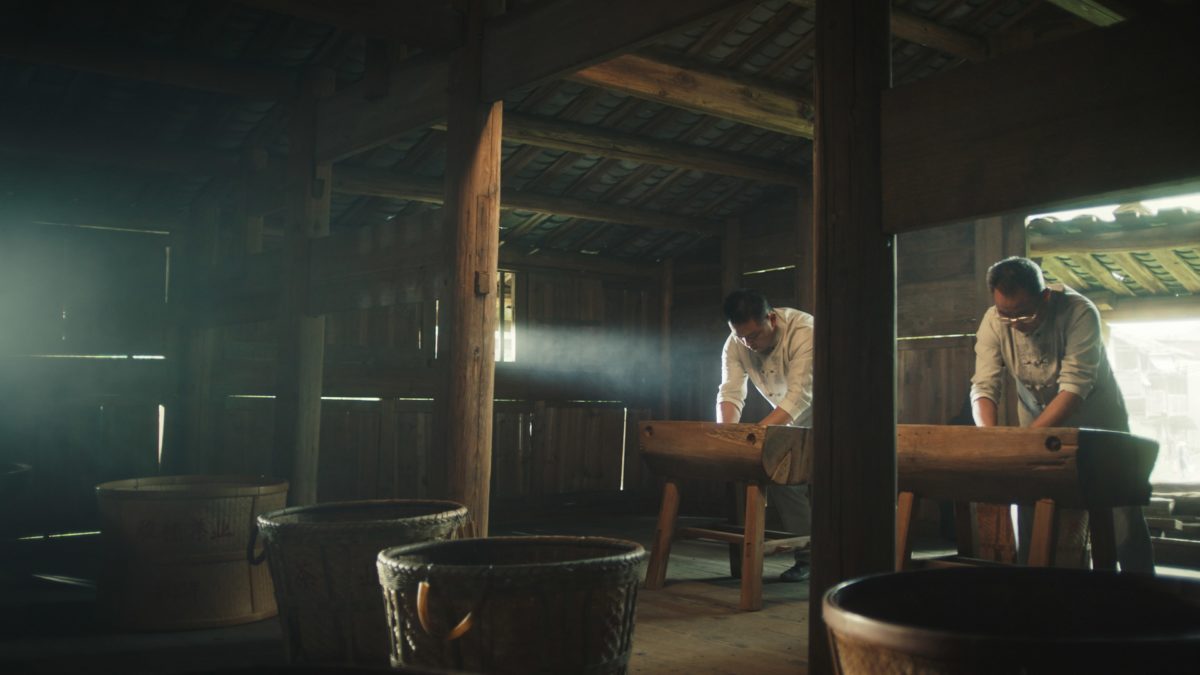
Mogan Huangya
 (Mogan Yellow Buds)
(Mogan Yellow Buds)
Tea Makers: Xiangzhen WANG and Xianqin ZHAO
Tea Bush: Jiu Keng and Mogan Quntizhong
Process type: Yellow Tea
Origin: Moganshan, Deqing, Huzhou, Zhejiang, China
$20 USD | 25 grams
Product Link: https://sevencups.com/shop/mo-gan-huang-ya-mo-gan-yellow-buds/
Dry Leaf: Olive drab with delicate yellowing and silver inclusions from tips. Consistent plucking, clean, and readily aromatic with floral and ethereal qualities, reminiscent of bee’s wax or Turkish delights.
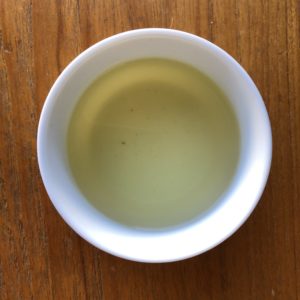
Infusion: Pale greenish-yellow. Clear with suspended down.
Cup: Aroma is honeyed, floral (fresh stock flower). Flavors crisp and delicate with mineral and cereal grain sweetness. Menhuang flavor development is executed with precision and restraint on the part of the tea maker, showcasing the purity of the material while shedding grass and straw. Floral and ethereal aromas of the dry leaf make a surprising return, persisting in the residual sweetness like an echo of Taiwanese Baozhong.
Personal Notes: Mogan Huangya is one of my favorite teas because it’s a dark horse. It lives in the shadow of more renowned yellow tea and also in the shadow of the pop-star-famous Anji Baicha that’s grown just west of it. For all of the painstaking skill and purity, it takes to make Mogan Huangya, it’s still so often overlooked. There’s something special about a well-kept secret, though. Sipping it still gives you the feeling that you’re experiencing something hidden — something only there for those who know where to look.
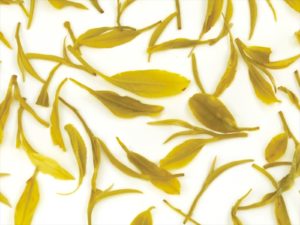 (Mogan Yellow Buds)
(Mogan Yellow Buds)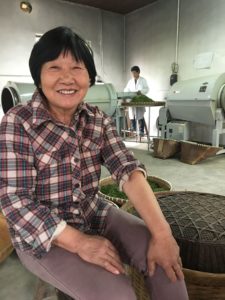
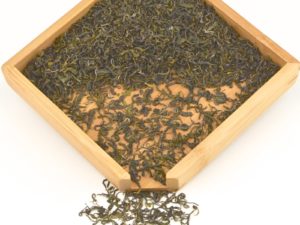
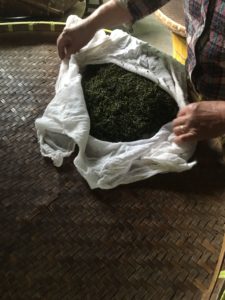
Hi Dan. What a great article!! I don’t like Chinese teas, but I certainly learned a lot about tea vocabulary and how to improve it. I’m heading to my spice cabinet right now!!
Cheers, David! Always up for a round of name-that-spice!
Excellent article with such deep, informative and eloquent responses from Andrew. Andrew is a true gem in our industry. Thanks Gents!
I’m honored to read this cheer from the big man himself! You’re too kind, Kevin. Thank you!
Very Nice Article!
Andrew I fondly remember meeting you at WTE 2019. COVID certainly curbed a number of plans in 2020. Hope we can connect in the coming year. Still very interested in what we discussed.
Thank you for reading, Michelle! Needless to say, 2020 has not been the year that any of us expected. I hope you’re doing well. Please feel welcome to reach out any time for a chat.